|
|
|
Sort Order |
|
|
|
Items / Page
|
|
|
|
|
|
|
| Srl | Item |
| 1 |
ID:
188758


|
|
|
|
|
| Summary/Abstract |
While it has become increasingly common for researchers, practitioners and policymakers to draw from the insights of former extremists to combat violent extremism, overlooked in this evolving space has been an in-depth look at how formers perceive such efforts. To address this gap, interviews were conducted with 10 Canadian former right-wing extremists based on a series of questions provided by 30 Canadian law enforcement officials and 10 community activists. Overall, formers suggest that combating violent extremism requires a multidimensional response, largely consisting of support from parents and families, teachers and educators, law enforcement officials, and other credible formers.
|
|
|
|
|
|
|
|
|
|
|
|
|
|
|
|
| 2 |
ID:
188759


|
|
|
|
|
| Summary/Abstract |
Presented here is an exploratory study that compared four kinds of extremists (violent lone, nonviolent lone, violent group member, and nonviolent group member). Thematic analysis of 40 case studies identified five key themes and a number of subthemes that comprised a range of underlying variables. Comparisons of the four groups showed that in many ways violent and nonviolent extremists acting alone or as part of a group do not differ. However there were some variables that distinguished between groups. Findings are discussed in terms of implications for countering and preventing violent extremism.
|
|
|
|
|
|
|
|
|
|
|
|
|
|
|
|
| 3 |
ID:
188761


|
|
|
|
|
| Summary/Abstract |
This article reports on a survey of researchers designed to capture current perspectives on core questions around cyberterrorism. The survey—conducted in 2017 as a follow-on to an initial, 2012, exercise—focused on questions of definition, threat and response. By documenting our findings in each of these areas—and highlighting developments in the years between our surveys—we identify three particularly important trends. First, an increasing convergence around the core characteristics of cyberterrorism, albeit with continuing conceptual disagreements at the concept’s penumbra. Second, increasing researcher concern with the threat posed by cyberterrorism, underpinned by a widespread view that this threat has increased, and a growing feeling that cyberterrorist attacks have now taken place. Third, support for a diversity of counter-measures to this threat, although perhaps counter-intuitively little suggestion that resort to exceptional or draconian measures is needed. In order to inform future research, the article concludes by detailing some of the major limitations, gaps and weaknesses within academic research to date as identified by our respondents.
|
|
|
|
|
|
|
|
|
|
|
|
|
|
|
|
| 4 |
ID:
188760
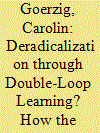

|
|
|
|
|
| Summary/Abstract |
The transformation of the Gamaa Islamiya can be understood by analyzing it against Argyris and Schön’s double-loop learning model. This paper bases the analysis on five books published by the Gamaa Islamiya, which include comprehensive elaborations on internal reflections and criticism of Al-Qaeda. While the Gamaa Islamiya’s learning can be framed with the model of double-loop learning, Al-Qaeda’s reactions can be depicted as a less evolved single-loop learning system. This case is relevant for the discovery of key mechanisms of de-radicalization that could be used as a blueprint for other groups.
|
|
|
|
|
|
|
|
|
|
|
|
|
|
|
|
| 5 |
ID:
188757
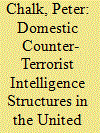

|
|
|
|
|
| Summary/Abstract |
This research note considers the origin, development, and functions of intelligence organizations in four selected democratic states, assessing their role in terrorism threat mitigation, their relationship with police forces, and the means and modalities by which they are controlled and monitored. The article is intended to help inform debate over the various strengths and weaknesses of establishing and maintaining dedicated security agencies that have no executive powers of arrest and which exist outside formal structures of law enforcement.
|
|
|
|
|
|
|
|
|
|
|
|
|
|
|
|
| 6 |
ID:
188754


|
|
|
|
|
| Summary/Abstract |
This article argues for recognition of fringe fluidity as a distinct radicalization pathway. Most studies on individual-level radicalization examine how relatively normal people come to accept violent extremist beliefs. But some people who come to accept and act on an extremist ideology transition from the embrace of one form of violent extremism to another—and understanding their prior extremism is essential to appreciating their ultimate beliefs and actions. The article demonstrates the existence of fringe fluidity by detailing the pathway between neo-Nazism and militant Islamism. Factors allowing fringe fluidity between these ideologies include recent cases of individuals who transitioned from one to the other or simultaneously embraced both; some ideological overlap, particularly in shared out-groups; and historical precedent that allows some adherents to reconcile inconsistent aspects of the two ideologies. Despite this article’s focus on neo-Nazism and militant Islamism, fringe fluidity is likely more widely applicable beyond the context of these two ideologies.
|
|
|
|
|
|
|
|
|
|
|
|
|
|
|
|
| 7 |
ID:
188765
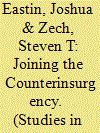

|
|
|
|
|
| Summary/Abstract |
What motivates civilians to fight in a progovernment militia? This article draws on survey and interview data from active members of Citizen Armed Forces Geographical Units (CAFGU), a progovernment militia in the Philippines, to evaluate why individuals enlist. We find poverty and unemployment to be key drivers of group membership, and the biggest attraction a steady paycheck. This situation presents a moral hazard for the Philippine government and other states that rely on impoverished citizens to wage counterinsurgency: while doing so can be cost-effective, the need to keep costs low might also impede efforts at socioeconomic or political reform.
|
|
|
|
|
|
|
|
|
|
|
|
|
|
|
|
| 8 |
ID:
188755


|
|
|
|
|
| Summary/Abstract |
Certain studies of social conflicts and geopolitical processes through online social networks entail qualitative analysis. One such issue is the tension between Western and Muslim societies. We introduce computer-assisted qualitative sentiment analysis for the inquiry and extraction of varied sentiments. The analysis explores the prevalent meanings of the term jihad through discussions of Muslims and non-Muslims in the online public sphere. After examining 4,630 Facebook comments and replies, our examination leads to a holistic mapping that details “peaceful,” “moderate,” and “radical” opinions regarding jihad, which is an integral institution of the Muslim world. Through this method, we suggest a “Muslim–non-Muslim tension indicator,” which can be used in a range of political analyses.
|
|
|
|
|
|
|
|
|
|
|
|
|
|
|
|
| 9 |
ID:
188764
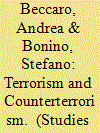

|
|
|
|
|
| Summary/Abstract |
The aim of this article is to understand why there has not been a successful jihadist terrorist attack in Italy. While it is impossible to offer a clear and unambiguous explanation, there are some unique aspects of the Italian case that should be emphasized and that can offer a convincing, albeit incomplete, answer to this narrative. The article will first highlight the fact that in Italy there have in fact been some attempted terrorist attacks and that the country has experienced jihadist terrorist activities. Subsequently, the article turns to an exploration of Italian counterterrorism in order to emphasize the most convincing and effective aspects, in particular the role of the legislation and the Antiterrorism Strategic Analysis Committee (CASA). Then, the article takes a more sociological perspective and analyzes the ways in which the social composition of the Muslim communities in Italy and their presence in its territories have affected the phenomenon of terrorism. In its conclusions, the article will reiterate why the country has remained exceptionally free of a successful terrorist attack, despite not being immune to jihadist propaganda.
|
|
|
|
|
|
|
|
|
|
|
|
|
|
|
|
| 10 |
ID:
188756


|
|
|
|
|
| Summary/Abstract |
In the early twentieth century Russian revolutionaries carried out suicidal assaults and validated them by anarchist and radical socialist rhetoric as fervently as jihadists today employ the idiom of Islamism. When death-seeking became a fashionable sociocultural trend in Russia, political subversives embraced terrorism as camouflaged suicide. For their part, Islamists uphold self-inflicted death by constructing environments in which martyrdom carries greater value than life. Headhunters recruit perpetrators of self-destructive attacks among those who covet death and link it to faith – socialist or jihadist. Rather than taking their own lives, the believers opt for publicly commended acts of suicide terrorism.
|
|
|
|
|
|
|
|
|
|
|
|
|
|
|
|
| 11 |
ID:
188762


|
|
|
|
|
| Summary/Abstract |
Research pays little attention to the diverse roles individuals hold within terrorism. This limits our understanding of the varied experiences of the terrorist and their implications. This study examines how a terrorist’s role(s) influence the likelihood of and reasons for disengagement. Using data from autobiographies and in-person interviews with former terrorists, we find that role conflict and role strain increase the probability of disengagement. We show those in certain roles, especially leadership and violent roles, incur greater sunk costs and possess fewer alternatives making exit less likely. Finally, certain roles are associated with the experience of different push/pull factors for disengagement.
|
|
|
|
|
|
|
|
|
|
|
|
|
|
|
|
| 12 |
ID:
188763
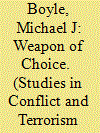

|
|
|
|
|
| Summary/Abstract |
Under what circumstances do armed groups in conflict choose to use terrorist bombings? This article challenges the conventional wisdom that terrorist bombings are done by either ideologically-driven or weak armed groups who have no reasonable prospect of success on the battlefield. Drawing from Mao’s theory of protracted struggle, it argues that terrorist bombings are a weapon of choice for armed groups that have transitioned into capable fighting armies but lack the degree of popular support they need to be a serious political contender. Using data on attributed terrorist bombings from 1998–2005, it finds that Islamist groups and older armed groups with sizeable membership are more likely to use terrorist bombings than smaller or newer groups.
|
|
|
|
|
|
|
|
|
|
|
|
|
|
|
|
|
|
|
|
|